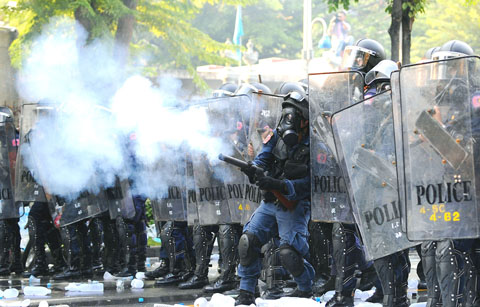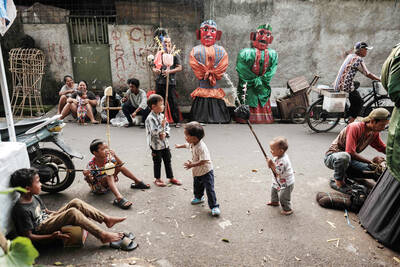Heavy-handed police tactics, including using tear gas canisters that explode on impact, have left a toll of horror injuries from street clashes in Bangkok, investigators and rights activists said.
Provocation from protesters — some of whom were armed and violently attacked police — was also to blame for the worst unrest seen in the Thai capital for 16 years, they said. The injuries sustained by protesters have shocked the country.
Newspapers have published graphic photos of people lying on the ground with their feet or lower legs blown off, while the Nation reported yesterday that one woman was in a vegetative state after suffering head injuries.

PHOTO: AFP
Police have been heavily criticized for using excessive force, firing tear gas on demonstrators blockading parliament to protest at a government plan to amend the Constitution.
The bloody clashes that followed saw two people killed and 478 injured.
Witnesses as well as photographic and video testimony showed violence from both sides.
Sunai Phasuk, Thailand analyst for New-York-based Human Rights Watch, said neither police nor the People’s Alliance for Democracy (PAD) could claim to have acted responsibly.
“We are calling on both sides to cease the use of violence and for PAD in particular to disarm themselves,” Sunai said. “They need to show their respect for democratic legal process... [and] the government has a responsibility to prove that all the actions taken on Oct. 7 were carried out according to the due process of law.”
“It’s become very clear that excessive violence was used,” Sunai said.
Forensic experts point to the severity of injuries caused by tear gas.
“The tear gas was a Chinese make, which can cause injuries like this,” said Porntip Rojanasunan, director of the Central Institute of Forensic Science.
Such injuries do not happen with Australian or US-made tear gas, she said, although she is awaiting a police sample to confirm her findings.
Porntip was originally called in by the army to investigate PAD claims that the police used bombs, but is now doing so for the independent National Human Rights Commission of Thailand.
She said that unlike the Western brands, the Chinese canisters explode when they hit an object before releasing their tear gas.
“I don’t think the police should use this type of tear gas, because it’s dangerous,” she said.
“The way they shoot at the people, they aim the gun directly at people so there could be serious injury,” she said.
The PAD movement has been trying for months to unseat the government, which it claims is effectively running the country for former prime minister Thaksin Shinawatra, who was ousted in a September 2006 coup.
For weeks now they have been occupying the central government offices, and have vowed to continue their rallies until Thai Prime Minister Somchai Wongsawat — a brother-in-law of Thaksin — and his administration step down.
Somchai, who on Saturday said he was considering resignation in the wake of the clashes, said the use of tear gas conformed to “international practice” but announced an independent investigation into the violence.
John Virgoe, Southeast Asia project director for the International Crisis Group, said an independent probe was important but unlikely to change anyone’s mind.
“My impression is that everybody has made up their mind about which version of events they adhere to based on their pre-existing views,” he said.
Society is bitterly divided between supporters of the populist government, mostly the rural poor, and the royalist elite who form the mainstay of support for the protesters.
A poll this week by Assumption University in Bangkok mirrored that gulf — half of those questioned supported the PAD and half were against.
Virgoe said police had not acted properly on Tuesday because they were not adequately trained in crisis management or properly equipped.
“Thai security forces just don’t have the range of techniques and the ability to respond to a security challenge in a nuanced and intelligent way. They either do nothing or they over-react. It’s a serious problem,” he said.

In the sweltering streets of Jakarta, buskers carry towering, hollow puppets and pass around a bucket for donations. Now, they fear becoming outlaws. City authorities said they would crack down on use of the sacred ondel-ondel puppets, which can stand as tall as a truck, and they are drafting legislation to remove what they view as a street nuisance. Performances featuring the puppets — originally used by Jakarta’s Betawi people to ward off evil spirits — would be allowed only at set events. The ban could leave many ondel-ondel buskers in Jakarta jobless. “I am confused and anxious. I fear getting raided or even

Kemal Ozdemir looked up at the bare peaks of Mount Cilo in Turkey’s Kurdish majority southeast. “There were glaciers 10 years ago,” he recalled under a cloudless sky. A mountain guide for 15 years, Ozdemir then turned toward the torrent carrying dozens of blocks of ice below a slope covered with grass and rocks — a sign of glacier loss being exacerbated by global warming. “You can see that there are quite a few pieces of glacier in the water right now ... the reason why the waterfalls flow lushly actually shows us how fast the ice is melting,” he said.

RISING RACISM: A Japanese group called on China to assure safety in the country, while the Chinese embassy in Tokyo urged action against a ‘surge in xenophobia’ A Japanese woman living in China was attacked and injured by a man in a subway station in Suzhou, China, Japanese media said, hours after two Chinese men were seriously injured in violence in Tokyo. The attacks on Thursday raised concern about xenophobic sentiment in China and Japan that have been blamed for assaults in both countries. It was the third attack involving Japanese living in China since last year. In the two previous cases in China, Chinese authorities have insisted they were isolated incidents. Japanese broadcaster NHK did not identify the woman injured in Suzhou by name, but, citing the Japanese

Eleven people, including a former minister, were arrested in Serbia on Friday over a train station disaster in which 16 people died. The concrete canopy of the newly renovated station in the northern city of Novi Sad collapsed on Nov. 1, 2024 in a disaster widely blamed on corruption and poor oversight. It sparked a wave of student-led protests and led to the resignation of then-Serbian prime minister Milos Vucevic and the fall of his government. The public prosecutor’s office in Novi Sad opened an investigation into the accident and deaths. In February, the public prosecutor’s office for organized crime opened another probe into